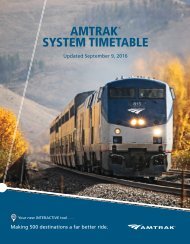Queens
northeast_queens_bus_study_-_final_9-28-15
northeast_queens_bus_study_-_final_9-28-15
Create successful ePaper yourself
Turn your PDF publications into a flip-book with our unique Google optimized e-Paper software.
, Metropolitan Transportation Authority<br />
Bus Bunching<br />
Comments were received regarding bus bunching on many of the routes in Northeast <strong>Queens</strong>. Many<br />
complaints were lodged about specific areas and specific routes that get bunched up.<br />
Bus bunching is caused by many factors including variations in traffic, the amount of time it takes for<br />
customers to load buses, building construction, utility repairs, traffic congestion, and unanticipated<br />
emergency or police activity. Each of these factors by themselves or in combination can lead to bus<br />
bunching on a route.<br />
When available, on‐street bus dispatchers are assigned to critical locations to monitor and adjust bus<br />
spacing as necessary. This may include holding a bus at a stop momentarily so that it will not immediately<br />
follow the bus that is directly ahead of that bus, or conversely the first bus may be directed to jump ahead<br />
and bypass the next several stops.<br />
In addition to on‐street supervision, the MTA deploys the new Bus Time technology to aid in the mitigation<br />
of these issues. Bus Time, which provides information for passengers based on the GPS location of the<br />
bus, provides essential information to MTA operations staff so that they can better adjust the timing and<br />
distribution of buses along the route. The system is new, and the MTA will continue to make more<br />
effective use of it to provide a better experience for all of our passengers.<br />
Reliability<br />
Comments were received regarding the reliability of buses in Northeast <strong>Queens</strong>. Complaints were made<br />
about late buses, buses that never arrive, and buses that are slow and take too long to reach their<br />
destination.<br />
MTA uses three principal metrics for measuring reliability of its routes: on‐time performance, wait<br />
assessment, and road reliability. Generally, Northeast <strong>Queens</strong> bus routes perform better than the <strong>Queens</strong><br />
and citywide averages for all three metrics. Detailed analysis of bus performance indicators by route are<br />
outlined in Section 4: Quality of Service of this report.<br />
Bus delays can be caused by a number of factors as noted above in Bus Bunching. Often congestion is the<br />
contributing factor to late buses. This is particularly true during the morning and evening peak periods<br />
and in congested Downtown Flushing and Downtown Jamaica. Bus delays can also be caused by<br />
mechanical issues and accidents.<br />
“Not in Service” is a display sign used when buses are running along city streets but are not available to<br />
pick up passengers. Buses may not be in service for several reasons, sometimes due to mechanical issues,<br />
returning to the depot at the end of the bus operator’s shift, or when the bus itself is transitioned from<br />
one route to serve a different route (this is known as “interlining”).<br />
In some instances, buses display “Next Bus Please” when they are delayed and have been informed by<br />
dispatchers to jump ahead and not accept any new passengers, but continue to discharge passengers<br />
when requested. This is usually done is conjunction when another bus is close by providing duplicative<br />
service. This action allows a bus to fill any excessive gaps in service between it and the preceding bus<br />
ahead of it.<br />
60



